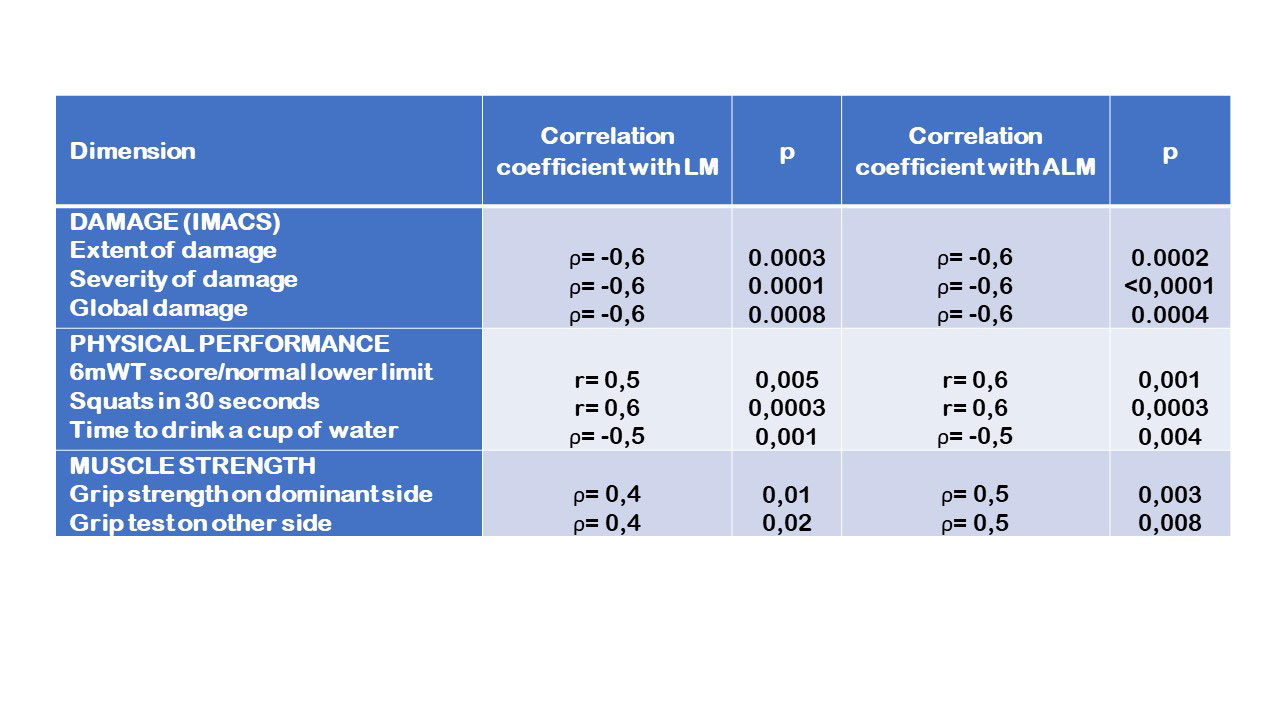Session Information
Session Type: Poster Session A
Session Time: 1:00PM-3:00PM
Background/Purpose: Myositis are autoimmune diseases characterized by muscle inflammation and weakness. Even when disease is no longer active, a great proportion of patients does not recover physical performance and residual muscle weakness persists.
Sarcopenia is a progressive and generalized skeletal muscle disorder characterized by low muscle strength and mass leading to disability, decreased quality of life and increased mortality. It has been reported in various autoimmune diseases, but it has never been studied in myositis.
The aim of this study was to investigate prevalence and significance of sarcopenia in myositis patients with low or no disease activity.
Methods: Adult myositis patients according to 2017 ACR/EULAR classification criteria, with disease duration greater than 12 months, stable medication for 6 months, creatine kinase serum level (CK) less than 500 U/l were enrolled. 30 healthy sex and age-matched controls were also included.
At the enrolment, total (LM) and appendicular lean mass (ALM) were measured using dual-energy X-ray absorptiometry (DXA) and grip strength using dynamometer. Sarcopenia was defined according to the European Working Group on Sarcopenia in Older People 2 consensus. Disease activity and damage according to International myositis assessment and Clinical Studies Group (IMACS). Muscle strength was measured by manual muscle test (MMT-8; MMT-12) and hand-held dynamometer, physical performance by 6-minute walking test (6mWT) and disability by Health Assessment Questionnaire (HAQ).
Results: 34 patients were prospectively enrolled. They suffered from DM (n= 5), necrotizing autoimmune myopathy (NAIM, n=10), anti-synthetase syndrome (ASS, n=11), scleromyositis (SM, n=8) since 4.9 years (3.0-8.6). 7 patients (20.6%) were sarcopenic (vs 0% in controls) (figure 1).
At the enrolment, sarcopenic patients were globally weaker; they had a lower physical performance and a greater disability. Both extent and severity of damage score according to the IMACS were significantly higher in sarcopenic patients (figure 2). LM and ALM negatively correlated with the IMACS damage scores, and positively with the physical performance parameters and with grip strength (figure 3).
Sarcopenic patients generally suffered from NAIM. Consistently, they had higher maximum CK levels. Moreover, 50% of sarcopenic patients had myocarditis. By contrast, extramuscular involvements were less frequent and none of sarcopenic patients had inflammatory joint involvement during the follow-up (figure 1).
In a multivariate analysis, myositis subtypes and myocarditis were independently associated with sarcopenia (respectively p=0.04 and p=0.001).
Interestingly, sarcopenic patients required more frequently aggressive therapy as intravenous immunoglobulins (83.3% vs 33.3%, p=0.03), plasmapheresis (33.3% vs 3.7%, p=0.02) and/or janus kinase inhibitors (16.7% vs 0 (0%), p=0.03).
Conclusion: Prevalence of sarcopenia in myositis with inactive or low activity disease is more than 20%. Sarcopenic patients are a subgroup with severe muscle disease, important damage and disability. Muscle mass measured by DXA is a quantitative tool to rapidly assess muscle damage in myositis.
IMACS: International Myositis Assessment and Clinical Studies Group. 6mWT: 6-minute walking test.
To cite this abstract in AMA style:
Giannini M, Debrut L, Charles A, Pizzimenti M, Javier R, Geny B, Meyer A. Sarcopenia in Myositis Patients: A Marker of Muscle Damage Associated with Myositis Severity and Disability [abstract]. Arthritis Rheumatol. 2022; 74 (suppl 9). https://acrabstracts.org/abstract/sarcopenia-in-myositis-patients-a-marker-of-muscle-damage-associated-with-myositis-severity-and-disability/. Accessed .« Back to ACR Convergence 2022
ACR Meeting Abstracts - https://acrabstracts.org/abstract/sarcopenia-in-myositis-patients-a-marker-of-muscle-damage-associated-with-myositis-severity-and-disability/



